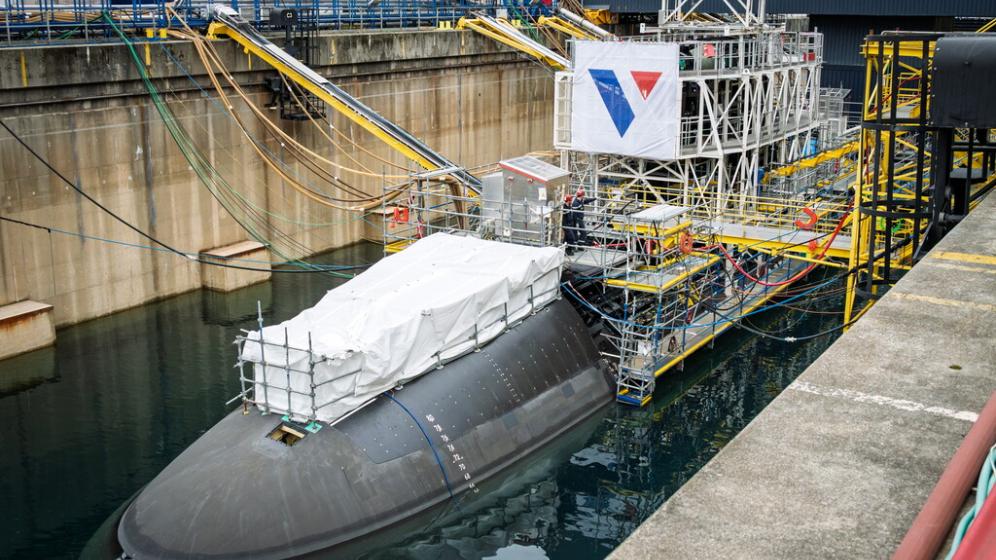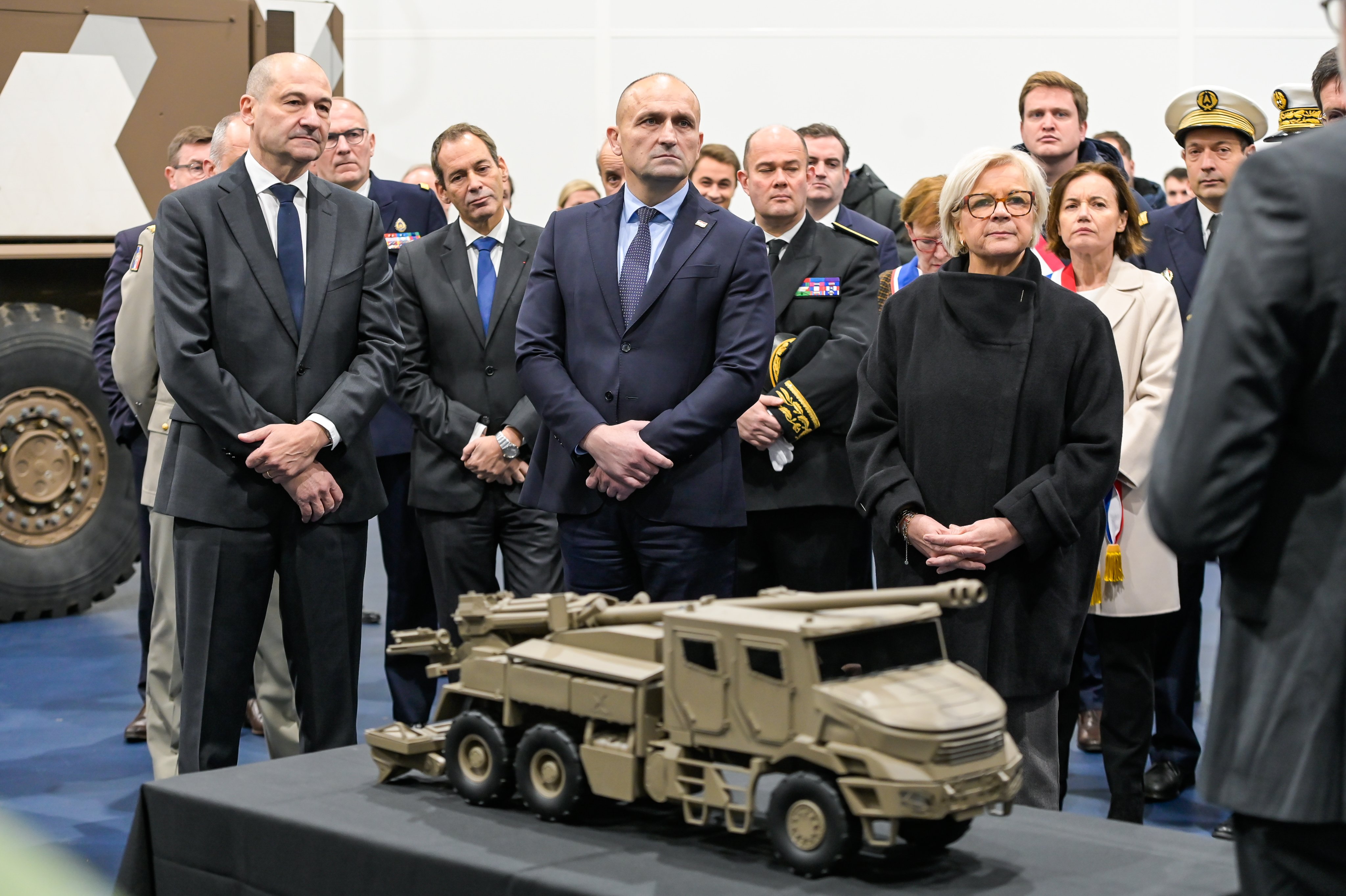Of the permanent members of the UN Security Council, the United Kingdom has the smallest deterrent force, with fewer than 200 warheads and a single delivery system. Successive British governments’ policies for nuclear interdependence with the United States over the past 50 years have led to a growing technological dissymmetry with the Americans. This politico-strategic choice now considerably restricts Britain’s options for remaining a member of the club of nuclear powers into the future.
The future of the British deterrent force
In the United Kingdom, nuclear deterrence has never embodied the symbolism that in France is so inherent in the ‘force de frappe’. On the French side of the Channel, nuclear deterrence fulfils many roles, two of which are deeply rooted in the French psyche: to prevent any repeat of May 1940, in other words military, political and moral collapse following a strike by a determined enemy; and to safeguard the ability of the French authorities to take independent decisions and hence avoid being subject to extreme and humiliating international pressures such as those suffered, for example, by the Fourth Republic, especially during the Suez affair in 1956.
History
In the United Kingdom, nuclear deterrence became a necessity at the end of the 1940s when it was feared the United States could remain relatively inactive in the event that the vital interests of the United Kingdom were being threatened by the Soviet Union. British opinion understood and accepted this requirement as long as Moscow could directly attack the British Isles. However, a significant element of British opinion was more sceptical but was obliged to grudgingly accept the situation. The political outcome of this was a lack of general consensus behind the deterrence principle despite the fact that public opinion polls showed that a majority of the British people remained in favour. Before the 1970s, opposition to nuclear weapons had been largely dormant, but with the ‘Euromissiles’ affair this erupted into an aggressive movement epitomised by the dynamism of the Campaign for Nuclear Disarmament (CND), the emblematic anti-nuclear pressure group within the United Kingdom.
This opposition encouraged debate, usually interminable and unedifying, on the moral, legal or political aspects of deterrence. Two major lines of reasoning are currently advanced on the British side of the Channel in the dispute about nuclear weapons. The first of these relates to nuclear disarmament, and a conference about amendments to the Non-Proliferation Treaty is programmed for 2010: the British could run counter to the treaty by not disarming and by accepting transfers of technology and nuclear material from the Americans. The other motives behind the opposition concern the British government’s international priorities, which should be promoting ‘human security’–a subject that is very fashionable in post-modern Anglo-Saxon and Scandinavian societies–and the fight against climate change that threatens international stability, rather than becoming preoccupied with the replacement of a British deterrent force that would not address these new threats.(1)
This context explains the extreme reluctance of the United Kingdom to debate deterrence, regardless of the political party in power, and also their acknowledged tendency to portray it in a very general, even cryptic manner. They have also demonstrated a certain propensity towards concealment with a distinct preference for taking decisions without reference to Members of Parliament; this was typified by the Chevaline project in the 1970s. To improve their chances of penetrating Soviet defences, the British started development of Multiple Re-entry Vehicle (MRV) warheads for their Polaris missiles.(2) The project was found to be far more expensive than initially forecast. More than a billion pounds were spent without the House of Commons being informed or having a chance to debate the matter. Faced with the delays and problems encountered by the project, Francis Pym, the Secretary of State for Defence under Margaret Thatcher, was obliged to reveal the existence of the programme, which had been launched under a Labour government.
The idea of replacing the Trident force was first raised in public in the White Paper of December 2003.(3) Today, while the Blair government considers that it will have to take a decision in one or two years on the renewal of its deterrent force, some in the Labour Party, such as Clare Short, think that the decision has already been taken.(4) The last Defence Secretary, John Reid, tried to give the impression that, while not evading the question, he was making every effort not to give a direct answer.(5)
Communication and public opinion
One should not therefore be surprised that the officially stated British deterrent policy has been based on a form of words where reference to nuclear weapons is reduced to its most basic level. In the early 1980s, while the Euromissile crisis was dividing British society, the 1984 Defence White Paper contained only one paragraph, out of 517, on the British deterrent. The end of the Cold War has not fundamentally changed the British perception of the role of nuclear weapons. However, it should be noted that in 1993 the then Defence Secretary, the Conservative Malcolm Rifkind, announced that the Trident missiles would be assigned a sub-strategic role in addition to their strategic functions. In the 1998 Strategic Defence Review (SDR), only two terse paragraphs were given over to the British deterrent force. Paragraph 60 stated that ‘Deterrence is about preventing war rather than fighting it’; paragraph 61 said that ‘Transparency about nuclear weapons holdings also plays a part in arms control’. In the New Chapter to the SDR, published in July 2002, somewhat indirect reference was made to the role of the British deterrent against massive terrorist attacks: ‘The UK’s nuclear weapons have a continuing role in guaranteeing the ultimate security of the UK’. In October 2005, the British Prime Minister told the House of Commons that, while no one pretended that the British deterrent force was a protection against terrorism, ‘I believe that [the independent nuclear deterrent] is an important part of our defence . . . It is too early to rule in or rule out any particular option’.(6) More recently, the Chancellor of the Exchequer, Gordon Brown (expected to succeed Tony Blair as Prime Minister) stated clearly his support for ‘retaining our nuclear deterrent’.(7) In a NATO context, the United Kingdom aims to periodically register its nuclear role and at its instigation a statement from the Nuclear Planning Group in June 2005 referred to the contribution from the United Kingdom’s independent nuclear force to the security of the Alliance.
US influence
This nuclear information policy also enables Whitehall to avoid having to define precisely Britain’s position as an independent nuclear power that is nevertheless closely dependent on the United States. After the Suez crisis in 1956, London made the decision to accept interdependence with the Americans, and presented this as the best strategic option for the United Kingdom.(8) This was the gist of the joint statement by Eisenhower and Macmillan in October 1957, the ‘Declaration of Common Purpose’. A few months later, this policy was formalised in the agreement of 3 July 1958 (Agreement for Cooperation on the Uses of Atomic Energy for Mutual Defence Purposes, known as the Mutual Defence Agreement–MDA). In 2004, these agreements were, according to various sources, extended to 2014. This ‘interdependence’ will not prevent the British, to their cost, finding themselves in a position of increasing technological inferiority trailing behind the Americans; this was well illustrated by the Skybolt episode, shortly after the signing of the MDA in 1958.
According to some estimates, 16 Anglo-American working groups are currently working on nuclear defence matters.(9) The British nuclear military complex is the responsibility of Atomic Weapons Establishment Management Limited (AWEML) in which the United States has financial interests. While AWE remains government property, its management and its activities have, since 1993, been subcontracted to a private consortium involving Lockheed Martin, Serco(10) and BNFL.(11) AWEML operates two military nuclear sites, at Aldermaston and Burghfield. Both these facilities are being upgraded with nearly £1.5 billion invested by the British government over the period 2005-08. 55% of this investment is assigned to operating costs and 45% to equipment modernisation, primarily involving the build of the Orion(12) high-energy laser that will replace the 25-year old Helen laser whose capacity is considered inadequate for simulations associated with the safety and reliability of British nuclear weapons.
The two nations are jointly involved in the operation of the Versatile Intermediate Pulsed Energy Reactor (VIPER) facility at Aldermaston as well as in the use by the British of the X-ray simulator X SPHINX (Short Pulsed High Intensity Nanosecond X-Radiator) located in New Mexico and coming under the Sandia National Laboratories.(13) In March 2006, the British are reported to have tested a detonator trigger for nuclear weapons in the Nevada desert (Operation Krakatau).(14) This new type of bomb is supposed to be part of the Reliable Replacement Warhead(15) programme intended for the US and British arsenals. This should come as no surprise, as the nuclear warhead fitted to the British Trident D5 missiles is already a copy of the W76 fitted to the US Trident. It should also be noted that the United Kingdom is also the only country with its own nuclear force that accepts the basing on its soil of foreign nuclear weapons. Currently more than a hundred free-fall nuclear weapons (B61) are thought to be stored at the Lakenheath(16) airbase for the use of the US Air Force (48th Fighter Wing).
Neither France nor the United Kingdom has ever really sought cooperation with the other on nuclear defence matters. Positive ‘signals’ emerged from the British side when, after France had carried out a nuclear test in 1960, some members of the Macmillan Cabinet (Peter Thornycroft, Minister for Defence and Julian Amery, Minister for Aviation) announced that they were in favour of an ‘entente nucléaire’ between the two nations. Such largely minority positions within the British Cabinet came to nothing, especially once the Nassau Agreement (December 1962) had further strengthened the links between London and Washington in nuclear defence. While there can be no technical cooperation between France and the United Kingdom because of the legal restrictions imposed on the latter arising out of the nature of its cooperative agreements with the United States, the two European powers nevertheless share a similar concept of the role of nuclear deterrence. At the beginning of the 1990s, London and Paris thus decided to set up a joint committee on nuclear defence. Twice, first at the meeting at Chequers in 1995 and then at the one held at Le Touquet in 2003, the leaders of the two nations also stated that any threat to the vital interests of the one was a threat against the other. The ‘French dimension’ also exists in the United Kingdom, from a viewpoint that could sound very strange to French ears: the British often employ the argument that as long as France has nuclear weapons, the United Kingdom has to do the same. For the British this is a concept arising out of the time-honoured rivalry that remains much more deeply ingrained than on this side of the Channel. When questioned in the review published by the Royal United Services Institute for Defence and Security Studies (RUSI) about the future of the British nuclear deterrent, an ex-senior manager of the British nuclear programme bluntly asked: ‘Would Europe wish France to be the only nuclear weapon state?’.(17) According to another British expert, from King’s College, ‘when politicians express themselves freely they suggest that the only factors that persuade the United Kingdom not to renounce nuclear deterrence are a nationalistic instinct and the traditional rivalry with France’.(18)
Domestic politics
From the viewpoint of domestic politics, while the Conservatives never called into question the decision to develop nuclear weapons during the Cold War, the consensus in their ranks has lost its edge despite the fact the a large majority remain in favour of the United Kingdom retaining a nuclear deterrent force. Thus Michael Portillo, Defence Secretary (1995-97) in the John Major government, has stated that he favours the abandonment of the British nuclear force. In his view, the United Kingdom should spend the sums thus saved on the development of its conventional forces to become ‘a better ally of the Americans’.(19) The Labour Party has always expressed a somewhat equivocal opinion on deterrence that doubtless reflects the split between the party base and its leaders, and between some party parliamentarians and the Government. In 1964, the Labour government played down the independent dimension of the British deterrent, by confirming that the only hypotheses for independent use were associated with the Chinese dimension (Beijing had recently carried out its first nuclear weapon test). Once back in opposition, the Labour party remained for a long time in favour of unilateral nuclear disarmament. This was stated in their general election manifesto in 1983: ‘Labour's commitment is to establish a non-nuclear defence policy for this country.’ This attitude would contribute, amongst other factors, to the defeat of Labour at various general elections prior to 1997. By this time, Labour had come round to supporting the retention of the British deterrent,(20) with, as a concession to the wing of the party that was most opposed to nuclear weapons, a limit to the number of warheads carried by the Trident II D5 missiles (48 per submarine according to the SDR).(21) Discordant voices are still making themselves felt within the party. Former Foreign Secretary Robin Cook(22) came out in favour of cancelling the modernisation of Trident, while his successor as head of the FCO, Jack Straw,(23) openly supported it, and in June this year, in his race to succeed Tony Blair, Gordon Brown, Chancellor of the Exchequer, declared his preference for the modernisation of the British nuclear force.(24) Opposition to nuclear weapons could also be found in military circles; for example, several retired generals, including Field Marshals Lord Carver and Lord Bramall, candidly stated, in the 1990s, that they favoured the renunciation of nuclear weapons by their country.
Today, at a time when the British government might want to take a decision on the Trident replacement, an upsurge in opposition could occur. To the traditional opponents (CND, the Churches and some Labour Party members) must now be added the Scottish dimension. The Trident submarine base is located at Faslane in Scotland, where the Scottish National Party, the main opposition within the Scottish Parliament(25) is committed, if its gains power, to ending the basing of Trident submarines in Scotland. Of course the Scottish Parliament has no jurisdiction over defence matters; nevertheless, this ‘Scottish dimension’ is an aspect that must now be taken into account by the Blair government.(26)
The United Kingdom is now the nuclear power with the smallest deterrent force, with fewer than 200 warheads(27) and a single system for their delivery. This force consists of four Vanguard-class submarines–HMS Vanguard (S28), Victorious (S29), Vigilant (S30) and Vengeance (S31). All are based at Faslane,(28) in Scotland. They were built by VSEL (Vickers Shipbuilding & Engineering Limited) at the Barrow-in-Furness shipyard. The Vanguard, the first of class, entered service in 1994, the last (Vengeance), in 2001. The first two submarines will be modernised between 2005 (S28) and 2008 (S29);(29) they have an estimated life of 25 years. This modernisation will be carried out in the Devonport shipyard (Plymouth), which is owned by the private group DML, of which the company Halliburton holds 51% of the capital.(30) Cost of ownership of this force is estimated at between 2 and 4% of Britain’s defence budget over the period 1994-2005. In the defence planning document prepared by the first Blair government, the Strategic Defence Review of 1998, it was announced that the British SSBNs would be placed on a reduced alert state. The last Vanguard is due to be decommissioned in 2024. According to ex-Defence Secretary Geoff Hoon, the decision to replace Trident will have to be taken during the life of the Parliament voted in at the May 2005 election.(31) Various options have been mentioned, especially in the context of the Maritime Underwater Future Capability (MUFC).(32)
This involves, based on projects submitted by BAE Systems and Rolls-Royce, the development of a new class of multirole nuclear attack submarine to replace not only the Vanguard class but also the Trafalgar-class SSN. These new submarines, almost certainly a modified version of the new British Astute-class SSN,(33) could then be adapted to carry four Trident D or perhaps 16 launchers for Tomahawk cruise missiles fitted with a new type of nuclear warhead. The Atomic Weapons Establishment (AWE) was tasked in 2002 with undertaking feasibility studies into such a warhead using appropriate simulation methods.(34) Other options could be considered for the successor to the Vanguard. The first would involve extending the life of the submarines. This is the option adopted by the United States in its Nuclear Posture Review of 2002 with a life extension for the Ohio-class SSBN. Another option would be to re-assign the British deterrent to the Royal Air Force. The Future Offensive Air System (FOAS) project could, according to certain sources, include a nuclear mission with the carriage of cruise missiles with nuclear warheads. These various options are being studied and John Reid, indicating a certain distancing from earlier positions, stated in the Commons last April that the Government was still a long way from adopting a definitive view on this subject.(35)
Conclusion
The politico-strategic decision by the British authorities to enter into close cooperation with the United States on military nuclear matters has severely constrained the options open to the United Kingdom if it wants to continue to be a player in the club of military nuclear powers for the foreseeable future. We may not know the precise reasons for their concern, but at the start of the decade the British authorities were clearly more than a little preoccupied about the current and future state of their deterrent force; the reasons for this included the premature ageing of the warheads and the loss of skills in the specialised naval shipyards after the commissioning of the last Astute-class SSN. In 2004 the decision was suddenly taken to double investment in AWEML. In parallel, a study programme was initiated into possible successors to the Trident submarines, despite the fact that the latter could last beyond 2025 and the Americans were guaranteeing an in-service life for the Trident missiles that would take them to 2044. This ‘haste’ needs to be seen in the context of an internal political climate where opponents of the British deterrent are threatening to become increasingly active, making it more difficult for the Government to act.
From a French point of view, the British example amply demonstrates the judiciousness of the decisions taken by various French governments that, for more than 50 years, have made France a major independent nuclear player. At the same time we should also be concerned about the problems faced by the British, as any wavering on their part could indirectly impact on our intention to retain a national deterrent in the decades to come.
(1) According to figures published in the Financial Times, replacing the deterrent force would cost between £15 and £20 billion; James Boxell, ‘MoD tests water on Trident replacement’, Financial Times, 4 April 2006.
(2) www.fas.org/nuke/guide/uk/slbm/chevaline.html.
(3) ‘Delivering Security in a Changing World’, UK Defence White Paper, December 2003.
(4) Clare Short, ‘A New Nuclear Weapon is Irrelevant to the Real Issues’, The Independent, 1 November 2005.
(5) See the evidence given by John Reid to the House of Commons Defence Committee, 1 November 2005.
(6) Tony Blair, statement, House of Commons, Hansard, 19 October 2005.
(7) Mansion House speech, 21 June 2006
(8) For an analysis of the consequences today of the British and French strategic decisions following the Suez crisis, see Philip Stephens, ‘End of the road for Chirac and Blair’, Financial Times, 8 June 2006.
(9) ‘Britain’s Special Nuclear Relationship’, Mark Townsend, The Observer, 12 June 2005
(10) UK government service-provider company and the number one service provider to the British Ministry of Defence. The majority of its capital is held by Fonds Permira.
(11) BNFL employs 23,000 personnel. It is a holding company linking Westinghouse, Nexia Solutions and British Nuclear Group.
(12) Statement by Lord Bach, House of Lords, 12 July 2004
(13) The Sandia Corporation (a subsidiary of Lockheed Martin) manages, on behalf of the Department of Energy, the defence nuclear research facilities located in particular at Los Alamos (New Mexico) and Livermore (California).
(14) www.iiss.org/whats-new/iiss-in-the-press/april-2006/wicked-lessons-on-wmd
(15) Ian Bruce, ‘Britain and US working on nuclear warheads to replace Trident’, The Herald, 10 April 2006.
(16) The Lakenheath airbase is located 20 miles from Cambridge. The 48th Fighter Wing is the only US Air Force unit based in Europe to be equipped with the F-15E fighter-bomber.
(17) Tim Hare, ‘What Next for Trident?’, RUSI Journal, April 2005.
(18) Memorandum submitted to the United Kingdom Parliament, 2005, www.publications.parliament.uk
(19) Michael Portillo, The Sunday Times, 19 July 2005.
(20) This position would be long-lasting; the Labour Party Manifesto for the 2005 elections stated that ‘we are committed to retaining the independent nuclear deterrent’.
(21) The last British nuclear test, code named ‘Julin Bristol’, to validate the new warhead destined for the British Trident II D5, took place at the Nevada range on 26 November 1991.
(22) Robin Cook died suddenly in August 2005 aged 59. In 2003 he had resigned from his post as leader of the Labour Party in the House of Commons in protest against the war in Iraq.
(23) Interview with Jack Straw for the New Statesman, 14 November 2005.
(24) Speech by Gordon Brown, The Mansion House, London, 21 June 2006.
(25) The first Scottish Parliament since the Act of Union with the Westminster Parliament in 1707 was elected in May 1999. This election resulted from the Scotland Act 1998, which gave Scotland a degree of autonomy.
(26) A motion tabled in 2006 by the Greens in the Scottish Parliament demanding the non-replacement of Trident was rejected by 73 votes to 38.
(27) John Reid, House of Commons, 1 November 2005, op. cit.
(28) The submarines are based at Faslane (west coast of Scotland), the weapons are stored at Coulport and the maintenance is carried out at Devonport.
(29) Bernard Prézelin, Combat Fleets 2006 (Rennes: Éditions Maritimes & d’Outre-Mer, 2006).
(30) The other shareholders of DML are Balfour Beatty and the Weir Group.
(31) Defence White Paper, December 2003, ‘Delivering Security in a Changing World’. Some months later, the First Sea Lord, Admiral Sir Alan West, confirmed at a press conference at RUSI that the decision on the Trident replacement would be taken in the next two or three years.
(32) Prior to 2001, this was the Future Attack Submarine (FASM) project.
(33) The first Astute-class boat (S20) is due for launch in July 2007.
(34) Final assembly of the operational warheads is undertaken at the Aldermaston and Burghfield sites.
(35) John Reid, answer to a parliamentary question, Hansard, 19 April 2006. Mr Reid was replaced as Defence Secretary by Des Browne on 5 May.







